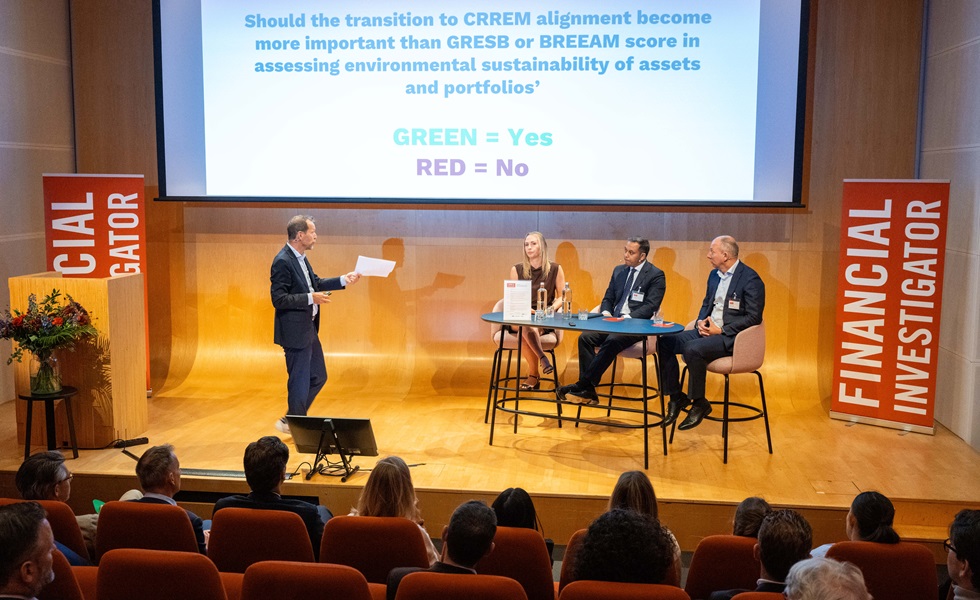Panel discussion: ‘How to create impact in real estate?’
Panel discussion: ‘How to create impact in real estate?’

This report was originally written in Dutch. This is an English translation.
Sustainability is no longer an optional, but an integral part of real estate investment strategies. Yet implementation remains complex. How do you realise your sustainability ambitions when you have to navigate between 13,000 indicators, sluggish permit processes and a jungle of rules and incentives? How do you stay on course in a playing field that is changing ever more rapidly?
By Baart Koster
|
MODERATOR Vincent van Bijleveld, Managing Director, Global Real Estate Engagement Network (GREEN), Managing Consultant Sustainable Investing, Finance Ideas
PARTICIPANTS Andrea Palmer, Responsible Investment Lead, Global Real Estate Securities, PGGM (at the time of the panel discussion) Jai Patel, Managing Director, Co-Head, Real Estate Debt, ICG Real Estate Paul Oremus, Country Manager, Manager Dutch Funds, CBRE Investment Management |
There is no doubt that sustainability has become a dominant factor in real estate investments. But the question of what exactly constitutes the benchmark for sustainable success gave rise to a variety of views during the panel discussion on 'How to achieve impact in real estate' at the 'Green Infrastructure & Sustainable Real Estate' seminar organised by Financial Investigator and chaired by Vincent van Bijleveld. 'With 13,000 indicators at our disposal, portfolio managers are losing track,' said Andrea Palmer, who until recently was responsible for listed real estate at PGGM. 'We have lost sight of materiality. The core risks are disappearing under a deluge of data.'
This realisation is also shared by other market players. Paul Oremus of CBRE Investment Management sees how benchmarks such as GRESB offer valuable insights, but at the same time lead to levelling: 'Many portfolios are now at a high level, making it difficult to really stand out. The focus must therefore shift to actually reducing emissions.'
Balancing GRESB and net zero
The debate about what should be prioritised – a high GRESB score or alignment with net zero targets – divides the room. A poll among the audience shows a preference for a hybrid approach: CRREM alignment should be given priority, without losing sight of social and other material ESG goals. 'It’s about striking the right balance,' says Jai Patel of ICG. 'We combine environmental objectives with social targets in our lending, for example by looking at the rent-to-income ratio in the residential sector and at energy efficiency.' According to Patel, it is more effective to assess impact at loan level than at fund level: 'That gives you more control over the content.'
If you really want to make a difference, you have to be prepared to take more risk. This is particularly true when it comes to transforming outdated real estate. 'You can't carry out thorough renovations within a pure core strategy,' Palmer emphasises. 'Brown-to-green means that an asset is temporarily unworkable and often involves development risk. This kind of impact requires a step higher on the risk curve.' Oremus also recognises this tension: 'Because core investors want to become more sustainable but avoid risks, in practice there is mainly room for mid-market investors to really make a difference – provided they have access to financing.'
We have lost sight of materiality. The core risks are disappearing under a deluge of data.
That is precisely where parties such as ICG are positioning themselves. Patel: 'We focus a large part of our time on mid-market sponsors and private property owners with outdated real estate. By providing loans of €30 to €75 million, we help them achieve institutional quality. The returns are value-add in nature and the impact is significant.'
Mismatch between desire and reality
When it comes to affordable housing, the mismatch between ambition and reality appears to be even greater. The need for new homes is enormous – more than a million in the Netherlands alone – but regulations, zoning plans and permit procedures are slowing down progress. 'Everyone wants to build in inner cities, but that automatically means high-rise buildings,' says Oremus. 'And with every extra floor, the costs increase.' At the same time, foreign capital is being deterred by fiscal unattractiveness and political uncertainty. 'Without an attractive investment climate, it will not be possible to achieve the necessary scale,' says Oremus. Patel adds that viability and healthy returns remain essential, especially in affordable housing. He notes that it is logical that a lower risk profile is accompanied by lower return requirements. 'But returns below 1% are unsustainable. The government must create the conditions under which institutional capital is willing to step in.'
Another bottleneck is that ESG factors are still not sufficiently taken into account in valuations. 'If you know how much CapEx is needed to bring a property up to energy label A or higher, you can model that,' says Oremus. 'But the prices that have been paid recently reveal that this assessment is often lacking.’ Palmer agrees: ‘In our portfolio of listed real estate, we have chosen to explicitly price in transition risk. Given the nature of investing in REITs, we felt that adjusting the required return threshold was the most logical way to do this. Ultimately, this means that we demand a higher return from companies with less detailed transition plans.'
What are you aiming for?
According to Patel and Palmer, a lack of standardisation is a major obstacle. 'Without a widely accepted methodology, no one knows what really counts,' says Palmer. 'An EPC label says little about where you stand in relation to a net zero path. It’s time to dig deeper and actively act as a knowledge partner for property owners who are lagging behind in terms of sustainability knowledge.'
If we really want to make sustainable housing a reality, we need clear frameworks and incentives.
One of the most discussed topics in the panel session is how ESG risks are factored into transaction valuations. 'In practice, we see major differences between market players,' says Palmer. 'Some explicitly incorporate sustainability into their cash flows and CapEx forecasts. Others do nothing with it – simply because they cannot, or do not know how.' And as previously argued, the speed of bidding processes in the property world often does not allow for thorough ESG analyses. 'Sometimes our partners have short deadlines to submit a bid – and then there is no time for in-depth analysis,' says Patel. 'As a result, sustainability often plays only a minimal role in pricing, even though the impact can be significant.' Palmer advocates for greater transparency and clearer benchmarks: 'CRREM is a useful tool because it indicates how far a building is from a net-zero trajectory. This helps investors better substantiate their CapEx assumptions and leads to more realistic pricing.'
Acceleration requires joint system choices
The bottom line is clear: without system changes, the impact will remain limited. The call for standardisation of sustainability criteria is louder than ever. And there is a need for policies that give investors the leeway to take the risks necessary for sustainability. 'We cannot leave everything to the market,' says Oremus. 'If we really want to make sustainable housing a reality, we need clear frameworks and incentives. Think of more stable fiscal policy, accelerated licensing procedures, and valuation methods that fully incorporate ESG.' This requires a collective step forward by investors, regulators, valuers and property owners. Only then can ambitions be translated into structural change, according to the shared opinion.
An important side effect of the ESG discussion is the changing role of institutional investors. Whereas they have long operated primarily as capital providers, there is now a visible shift towards more involved, sometimes even entrepreneurial roles. 'With our loans, we are not only on the financing side, but are also actively engaged in discussions about sustainability scenarios and performance criteria,' says Patel. 'That requires different skills, a different mindset and a willingness to invest time and capacity.' Palmer points to a broader interpretation of an active role, namely as a knowledge sharer and standard setter. 'As a large institutional investor, you can influence how ESG is integrated – not only through your own models, but also in discussions with appraisers, consultants and policymakers. We must take that responsibility.'
If you really want to make a difference, you need to be able to allocate flexibly - not only between asset classes, but also between impact and risk. That requires customisation and courage.
It has been repeatedly concluded that cooperation is crucial. Realising sustainable real estate is not the task of one party, but of the entire chain: from developer to financier, from government to end user. Oremus: 'We can scale up much faster if we learn to speak each other's language. That means that valuers must take ESG seriously, that regulators must provide clarity and that developers must be open to new financing models. It is not a technical issue, but primarily an organisational one.'
Strategic allocation: combine liquidity with impact
Finally, the question arises as to how investors can position themselves strategically. One answer lies in combining listed and private real estate. Listed real estate offers liquidity and gives pension funds the opportunity to manage their portfolios more dynamically, while private investments enable more direct impact. Palmer: 'By managing the allocations between the two, you can balance risks. If you take more sustainability-related risk in one segment, for example by investing more in brown-to-green projects, you can compensate for this elsewhere in your portfolio. This way of thinking is gaining ground.' Patel agrees, but emphasises the importance of flexibility in the deployment of capital: 'If you really want to make a difference, you need to be able to allocate flexibly – not only between asset classes, but also between impact and risk. That requires customisation and courage.' Palmer: 'The playing field is complex, but as an institutional investor, you can help shape the standard. That is precisely where our opportunity lies to really steer the transition.'
Green real estate requires more than ambitions and intentions. The panel discussion makes it clear that the sector is looking for guidance: in data selection, valuation, strategy and policy. The investment opportunities are there, both financially and socially, but they require active choices and acceptance of friction. Those who want to make an impact will have to dare to let go and break free from rigid definitions, linear return requirements, and the illusion that sustainability can be achieved without friction. The future of real estate is not only green – it is complex, strategic and in flux.
Pioneers take the lead
Those who position themselves in this field of influence now will soon reap the rewards of both impact and return. The panellists show that sustainable transformation starts with daring to choose: for transparency, for dialogue, and for pushing boundaries. Because making real estate sustainable is not a hype, but a social necessity – and those who do it well not only build value, but also trust. Infrastructure also plays a role in this transition: from energy supply to charging facilities for electric vehicles. Sustainable real estate does not stop at the building envelope – it affects mobility, behaviour, and the way people live and work. This is precisely where the opportunity lies for pioneers who think beyond rigid definitions and link systems thinking to concrete action. Patel: 'We shouldn't be asking ourselves whether we should do this, but how quickly we dare to go. Because every pound that is not invested sustainably today is a missed opportunity tomorrow.'
|
SUMMARY Sustainability is an integral part of real estate investments, but standardisation is lacking. Investors are struggling with the amount of data. GRESB scores do not provide sufficient guidance. The focus must be on actual emission reduction. Mid-market investors can make an impact, provided they are prepared to take more risk and share knowledge. ESG factors are often insufficiently taken into account in valuation and pricing. Faster procedures, stable policy and common frameworks are essential for upscaling. Strategic allocation requires flexibility, courage and active involvement from investors. |









